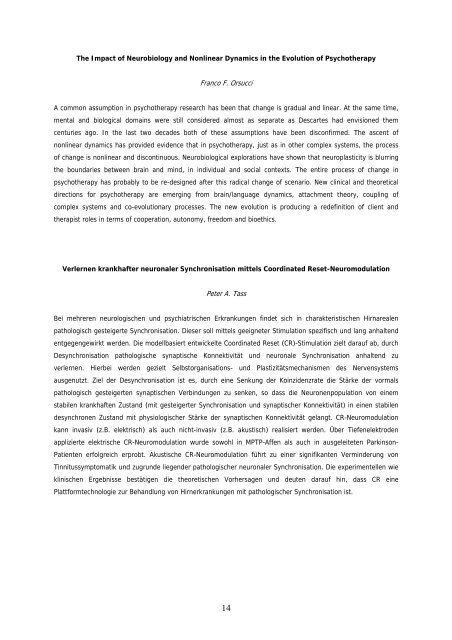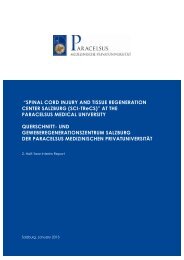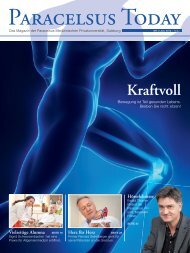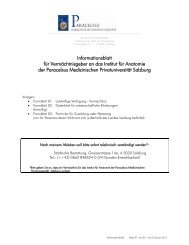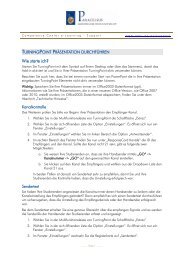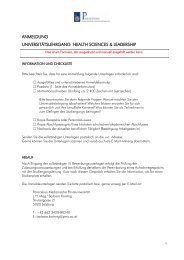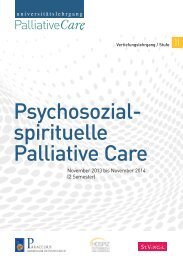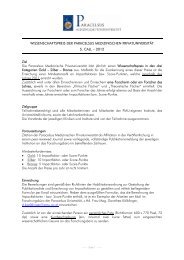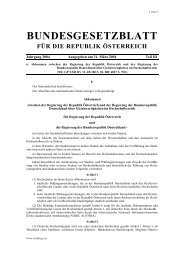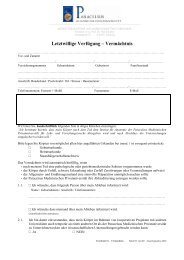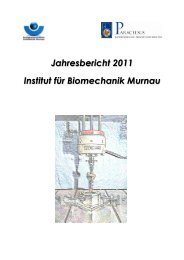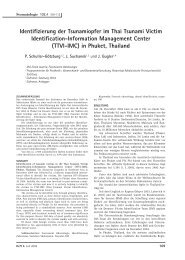Neurobiologie der Psychotherapie - PMU
Neurobiologie der Psychotherapie - PMU
Neurobiologie der Psychotherapie - PMU
Sie wollen auch ein ePaper? Erhöhen Sie die Reichweite Ihrer Titel.
YUMPU macht aus Druck-PDFs automatisch weboptimierte ePaper, die Google liebt.
The Impact of Neurobiology and Nonlinear Dynamics in the Evolution of Psychotherapy<br />
Franco F. Orsucci<br />
A common assumption in psychotherapy research has been that change is gradual and linear. At the same time,<br />
mental and biological domains were still consi<strong>der</strong>ed almost as separate as Descartes had envisioned them<br />
centuries ago. In the last two decades both of these assumptions have been disconfirmed. The ascent of<br />
nonlinear dynamics has provided evidence that in psychotherapy, just as in other complex systems, the process<br />
of change is nonlinear and discontinuous. Neurobiological explorations have shown that neuroplasticity is blurring<br />
the boundaries between brain and mind, in individual and social contexts. The entire process of change in<br />
psychotherapy has probably to be re-designed after this radical change of scenario. New clinical and theoretical<br />
directions for psychotherapy are emerging from brain/language dynamics, attachment theory, coupling of<br />
complex systems and co-evolutionary processes. The new evolution is producing a redefinition of client and<br />
therapist roles in terms of cooperation, autonomy, freedom and bioethics.<br />
Verlernen krankhafter neuronaler Synchronisation mittels Coordinated Reset-Neuromodulation<br />
Peter A. Tass<br />
Bei mehreren neurologischen und psychiatrischen Erkrankungen findet sich in charakteristischen Hirnarealen<br />
pathologisch gesteigerte Synchronisation. Dieser soll mittels geeigneter Stimulation spezifisch und lang anhaltend<br />
entgegengewirkt werden. Die modellbasiert entwickelte Coordinated Reset (CR)-Stimulation zielt darauf ab, durch<br />
Desynchronisation pathologische synaptische Konnektivität und neuronale Synchronisation anhaltend zu<br />
verlernen. Hierbei werden gezielt Selbstorganisations- und Plastizitätsmechanismen des Nervensystems<br />
ausgenutzt. Ziel <strong>der</strong> Desynchronisation ist es, durch eine Senkung <strong>der</strong> Koinzidenzrate die Stärke <strong>der</strong> vormals<br />
pathologisch gesteigerten synaptischen Verbindungen zu senken, so dass die Neuronenpopulation von einem<br />
stabilen krankhaften Zustand (mit gesteigerter Synchronisation und synaptischer Konnektivität) in einen stabilen<br />
desynchronen Zustand mit physiologischer Stärke <strong>der</strong> synaptischen Konnektivität gelangt. CR-Neuromodulation<br />
kann invasiv (z.B. elektrisch) als auch nicht-invasiv (z.B. akustisch) realisiert werden. Über Tiefenelektroden<br />
applizierte elektrische CR-Neuromodulation wurde sowohl in MPTP-Affen als auch in ausgeleiteten Parkinson-<br />
Patienten erfolgreich erprobt. Akustische CR-Neuromodulation führt zu einer signifikanten Vermin<strong>der</strong>ung von<br />
Tinnitussymptomatik und zugrunde liegen<strong>der</strong> pathologischer neuronaler Synchronisation. Die experimentellen wie<br />
klinischen Ergebnisse bestätigen die theoretischen Vorhersagen und deuten darauf hin, dass CR eine<br />
Plattformtechnologie zur Behandlung von Hirnerkrankungen mit pathologischer Synchronisation ist.<br />
14


